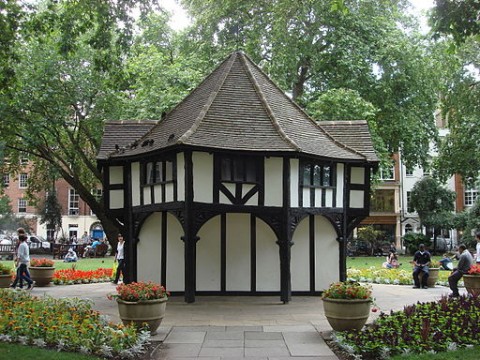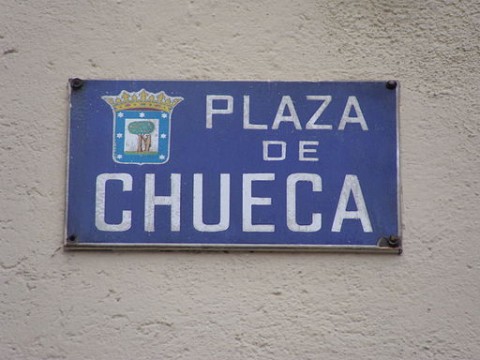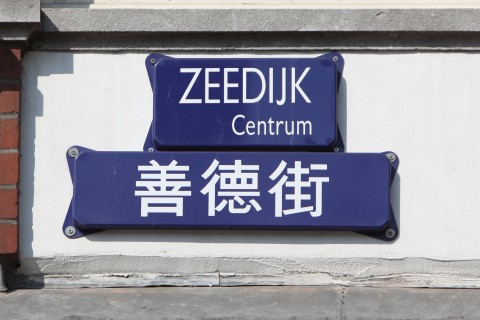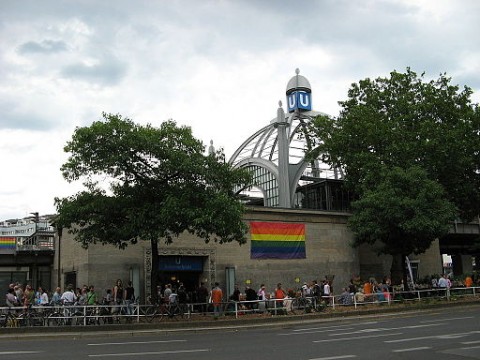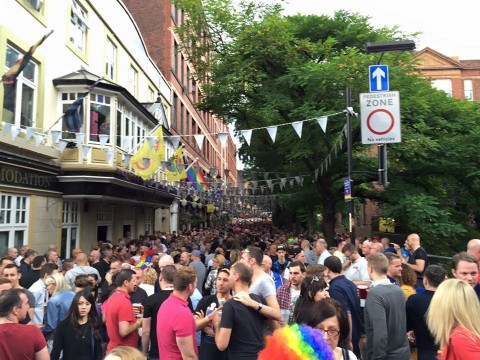Some people may argue that the notion of 'gay village' is outdated today, in an age of increased acceptance of LGBT people. Do we actually need separate neighbourhoods to socialise, get together, have fun? And has the advent of social apps reduced our need for such spaces, or for opportunities where we can feel 'majority'? All open questions, but we should not forget how these 'gay villages' are the custodians of our community's heritage and past, something we should treasure and learn from, especially the stories of the pioneers who established businesses and spaces in urban wastelands and at a time when gays and lesbians had to hide from an unfriendly mainstream society.
London: Soho
The connections between Soho and gay men goes back many decades. In the 19th century the area around Piccadilly Circus was famously known as 'the meat rack' because of the abundance of rent boys and a certain Oscar Wilde was a regular at local restaurants like Kettners (currently - sadly - under unspecified 'renovation'). At a time when gay men were actively pursued by the law, in the early to mid 20th century, the rather bohemian character of Soho was an obvious hideaway for the gays. However after the second World War the area went into a steady decline and it became a seedy neighbourhood where straight men found titillation in grotty porn shops and dirty strip theatres. So it may come as a surprise that the change happened in the early 80s when the uber-Conservative Westminster Council decided that it was time to 'clean' the area. Commercial licences were revoked and thus many bars and shops became empty. Coincidence wanted that right at that time the LGBT scene was starting to come out of its own closet and so the cheap rents attracted gay publicans: in 1986 the bar Comptons opened on Old Compton Street and the rest is pretty much history. Soho still today maintains a charming atmosphere, but many see the LGBT character of this area at risk, as many businesses are threatened with closure, forced by very high rental costs and by property developers eager to turn buildings into luxury flats or offices. Elements of the scene have since the late 90s migrated to other areas, i.e. Vauxhall (today also at risk of extinction due to 'gentrification') and East London. The heart of Soho is Old Compton Street, which is always buzzing and busy, especially at weekends. Comptons of Soho, which as mentioned above was the first proper gay venue on the strip. Other favourites are The Yard Bar on Rupert Street, with its open air courtyard and G.A.Y., also on Old Compton Street. If the sun shines, then Soho Square, with its pretty central garden is the place to be. Take a coffee or a beer, lay down on the lawn and watch the world go by - and the hot boys. Apart from the gay bars & shops, the area offers hundreds of amazing restaurants to choose from and also some colourful venues, like Bar Italia on Frith Street, which opened in 1949 and was one of the first places in London to serve Italian-style coffees. A great stop for cake lover is Maison Bertaux which is said to be London's oldest French patisserie.
(Photo credit: Panhard - Own work)
Madrid: Chueca
The Chueca district of the Spanish capital, taking its name from the square with the same name, is also situated right in the centre of the city and in a way it followed a very similar path as London's Soho. In the 1970s the neighbourhood was in terminal decline, rife with drugs, endemic crime and street prostitution. Shops and commercial premises stood abandoned and in ruins. With the legalisation of homosexuality after the long Fascist dictatorship of Francisco Franco, it was here in this neighbourhood, that the first gay bars opened, first clandestinely and then in the 1980s more and more visibly and in the open. An example is Cafe Figueroa (c/Figueroa, 17), which opened in 1981. At the beginning even these businesses were hesitant to stay open past 10pm, such was the level of crime in the neighbourhood. The first axis of this renaissance was Calle Pelayo, where still today many gay bars open their doors. In the 1990s the neighbourhood really changed into what we see today, it became increasingly desirable and trendy, fashion shops and many other businesses opened their doors, some of great importance, such as the Berkana LGBT bookshop, which started trading in 1993. Initially all this development did not encounter much assistance from the local government, but it was rather a community-instigated process. It was only in the late 1990s that finally the city recognised the value of the transformation of this neighbourhood and started helping, for instance pedestrianising Calle Fuencarral, which today is a beautiful shopping promenade. Today Chueca is still the very heart of the LGBT community in Madrid. There are indeed bars elsewhere in the city, but this is where it all happens. Come on any given night, especially over the long and hot summer months, and the whole area will be absolutely buzzing with life and fun. Bears and admirers will love the Bears Bar in c/Pelayo while girls should head to Escape and Truco in c/Gravina, both very popular. Some of the best drag shows are to be found at LL Show Bar in c/Pelayo And for a good boogie head to Delirio in c/Libertad, which is always busy but never before 1 or 2 AM. Another great place to visit is the San Anton Market which is a real temple to fine foods: here you will find some gorgeous food outlets, cafes and endless tapas opportunities, including a superb restaurant/bar with a panoramic terrace on top. Over the Pride week, in early July, the area becomes an enormous party zone, several stages for shows and performances are erected and the crowd swells enormously, in a huge, colourful street party where the whole city comes to play, a true symbol of how accepting and open Madrid is today.
Amsterdam: Zeedijk and Warmoestraat
The area around the Warmoestraat (literally 'Chard Street') is a very important area for the LGBT community, especially those into leather and fetish, with a pretty impressive and ground-breaking history. Rewind to a few decades past. Amsterdam has always been a beacon in LGBT tolerance. The first gay bar - 'T Mandje - opened in this very area in 1927 on the Zeedijk, run by Bet Van Beeren, one of the first leather 'dykes-on-bikes'. This iconic bar closed down in 1982 and re-opened recently, in 2008. It's definitely worth a visit and savour the historic atmosphere of the place. In 1955 a new hotel opened on Warmoestraat: Hotel Tiemersma - renamed Argos in 1959 - became famous for being completely revolutionary. It was the first leather bar in Europe, a very simple place but with featuring for the first time an (unofficial) dark room next to the basement toilets. And it is said that the hotel's rooms did not have locks, so to add to the option of easy man to man sex in situ. In the 1970s and beyond, many more bars and shops opened up in this area, so much that at the turn of the millennium, Amsterdam seemed to be the crowned capital for everything leather and fetish. But more recently the tide seems to have turned: many businesses have closed down, including the Argos, which ceased trading in 2015, after 60 years. As for other shops selling porn or sex toys, the internet has pretty much represented a death sentence for them too. Today there are a few gay bars left in this area, like Dirty Dicks and The Eagle, but it appears that the scene, at least the more mainstream one, has moved to other areas, such as the Reguliersdwarsstraat area, where bars like Soho and Taboo, together with newcomers like Club Church are the locals' favourites.
Berlin: Schöneberg
Everyone knows the musical and film Cabaret, depicting Berlin's bohemian and decadent life of the late 1920s and early 1930s. Most of the history told in Cabaret is set in the neighbourhood of Schöneberg, around the Nollendorfplatz. Christopher Isherwood, the author of the books upon which Cabaret is based lived just around the corner and one of the most famous and groundbreaking bars of the time, Eldorado, was located in Motzstrasse. Here straight and gay people queued to see the incredibly elaborate drag shows put up on a nighty basis in an incredible example of tolerance, almost a century ago. So the Schöneberg neighbourhood became a magnet for LGBT people from all over Europe and beyond, who could find an oasis of tolerance and live their sexuality almost openly. Sadly the advent of Nazism spelled a rapid end to the experiment; the bars were closed down and their clients who did not manage to escape in time ended up in jail or worse in the concentration camps. After the war the city was famously divided in two by the Wall and the Schöneberg district happened to be in the Western part. West Berlin had a particular feel in the 1970s and 80s: alternative, gritty, decadent and literally 'on the edge', an inch away from the Iron Curtain. In those years in which WWIII seemed to be imminent, artists like David Bowie and Iggy Pop lived in this neighbourhood. Post reunification, LGBT bars and clubs opened elsewhere in the city, including in the former DDR, like Prenzlauer Berg, but the Schöneberg area kept and in fact enhanced its reputation as one of Europe's biggest gay neighbourhood. Gone are the drag performances of the 1930s, but the area acquired a distinct leather/fetish and masculine character, hosting the famous Folsom Street Europe event in September each year and the Stadtfest Schöneberg in the summer. There are countless venues like Hafen, Woof-Berlin, Prinzknecht, Tom's Bar and Connections (both of which today offer accommodation as well), cafes like the very popular Romeo und Romeo, the 24 hour Berio and the posher Kalvil, restaurants and bistros like the uber-popular April and Sissi (which serves amazing Wiener Schnitzels, by the way) and shops selling all sorts of leather and fetish-wear.
(Photo credit: BelleVueLove - own work)
Manchester: Canal Street
One of the world's powerhouses during the Industrial Revolution, Manchester fell into decline in the post WWII years, when its textile industry moved elsewhere. One of the areas that felt the brunt of the crisis was the inner-city neighbourhood around Canal Street, which once housed storerooms and warehouses. In a story that is very similar to other LGBT neighbourhoods from Soho to Chueca, in the 1970s and 1980s the area was in terminal decline, rife with crime, prostitution and with a multitude of crumbling buildings. To make things worse, the Police and City Council did not help; in fact the former had a zero-tolerance (some would rather say a persecutory) approach to the gays using the desolate canal-side areas for cruising. However things started to change in 1990 when the bar Manto (an acronym for Manchester Tomorrow) opened its doors on Canal Street. Housed in a former car repairs garage, it was the first bar in town to feature open windows onto the street. It took a while for the area to change its flavour, but progressively other bars opened their doors, also helped by a change in the Police and City Council attitude towards the LGBT community, becoming supporters and promoters of equality and same sex marriage. Even landmark LGBT TV series like Queer as Folk contributed too popularise the rebirth of this area of Manchester as a new gay neighbourhood. Today the area around Canal Street is arguably the second LGBT area for importance in the UK after London. Along the street itself there are tens of bars, with crowds spilling over the pedestrianised canal-side walkway almost every night in the summer season. Manto closed in 2013 and its premises are now occupied by the popular On-Bar (by London promoters Orange Nation). But we can name so many other great venues, like G-A-Y (sister venue of the London's one), Kiki, Via, (with a contemporary pub menu) Villaggio (which serves excellent Italian-style food), and many others. There are now bars in other neighbouring streets as well, like The Eagle in Bloom Street, catering for a more masculine crowd. The H2O Sauna is located in Sackville Street. There is a peaceful green space in the Village: the Sackville Gardens also feature a much-loved monument to Alan Turing, decoder of the Nazi Enigma code and father of modern computing, persecuted for his homosexuality in the 1950s. The Gay Village comes alive on the last weekend of August (a public holiday long weekend) when Manchester Pride takes over the city. The parade takes place on the Saturday afternoon and concludes in proximity of Canal Street. A few years ago the controversial decision was taken to fence the entire Village and charge a small fee for entry, in order to cover some of the costs related to policing and to prevent overcrowding. Despite this, Manchester Pride is today a key event on the LGBT calendar and attracts tens of thousands of visitors to the city, so if you're planning to attend, book your hotel well in advance!
Cover Photo credit - By Pete - Flags and TreesUploaded by maybeMaybeMaybe, CC BY 2.0, https://commons.wikimedia.org/w/index.php?curid=22970420

